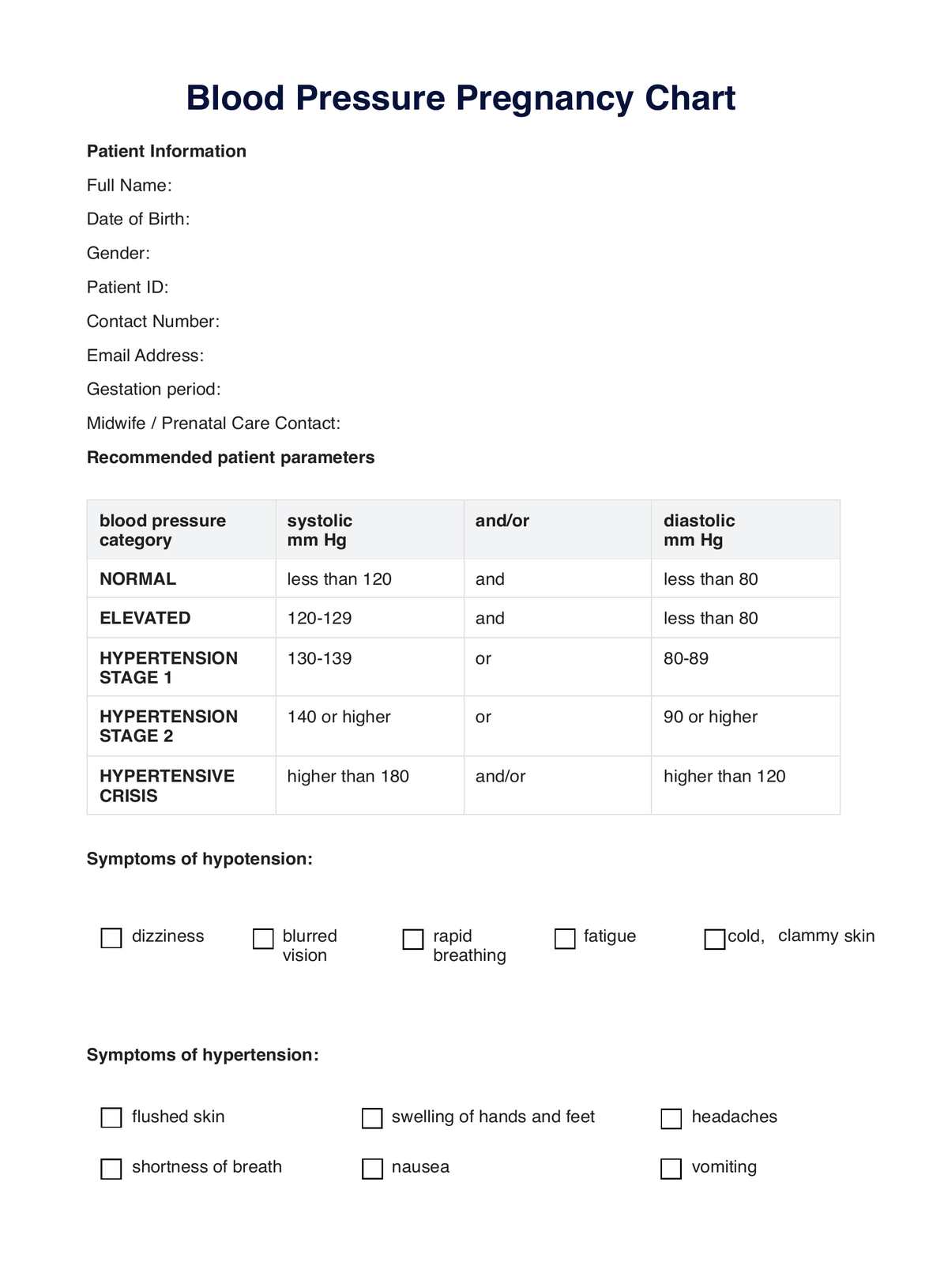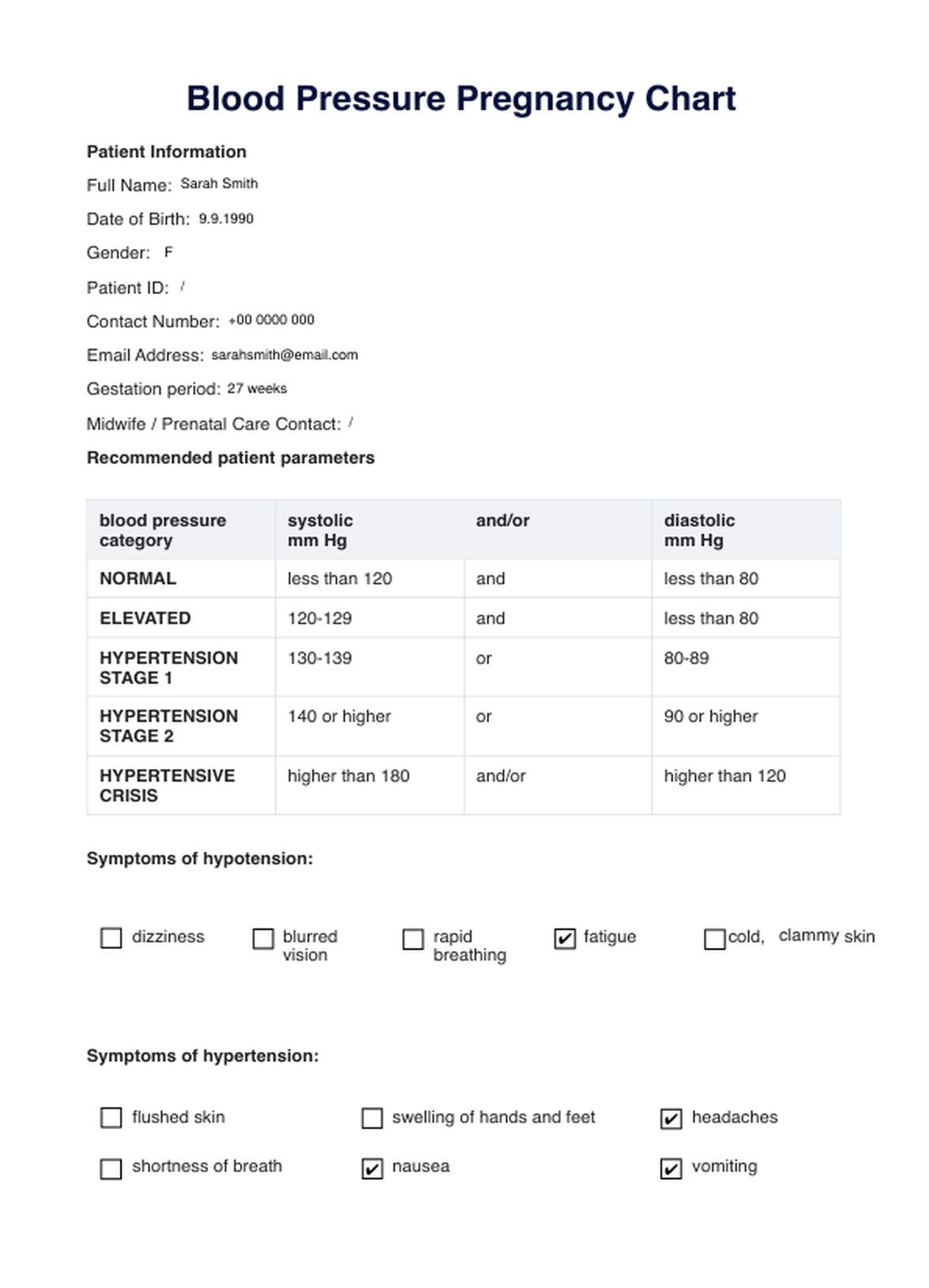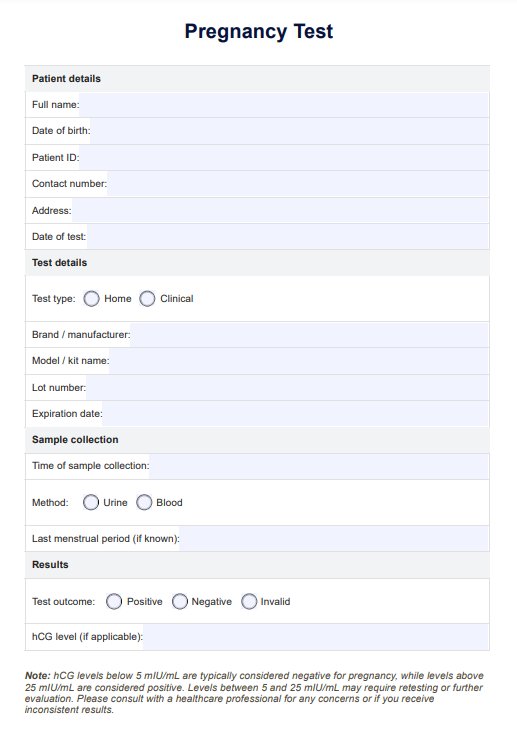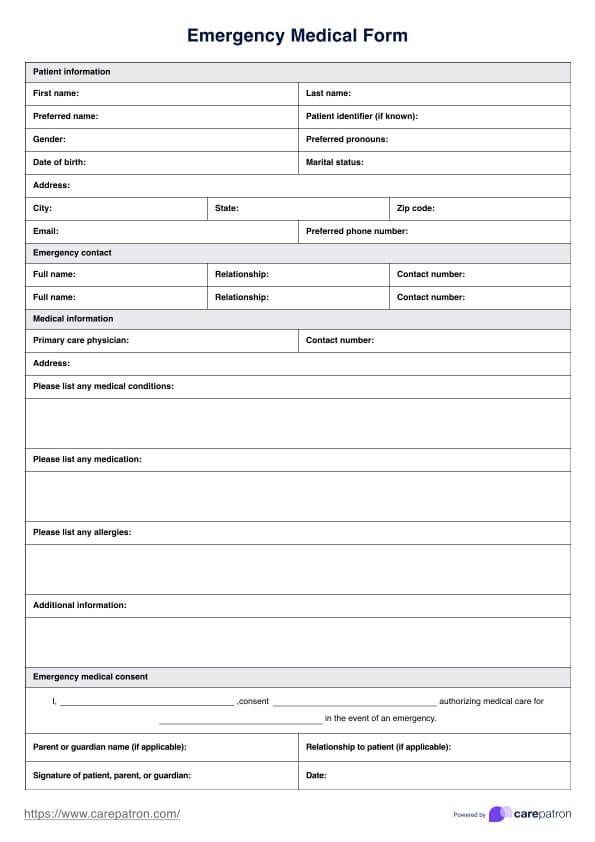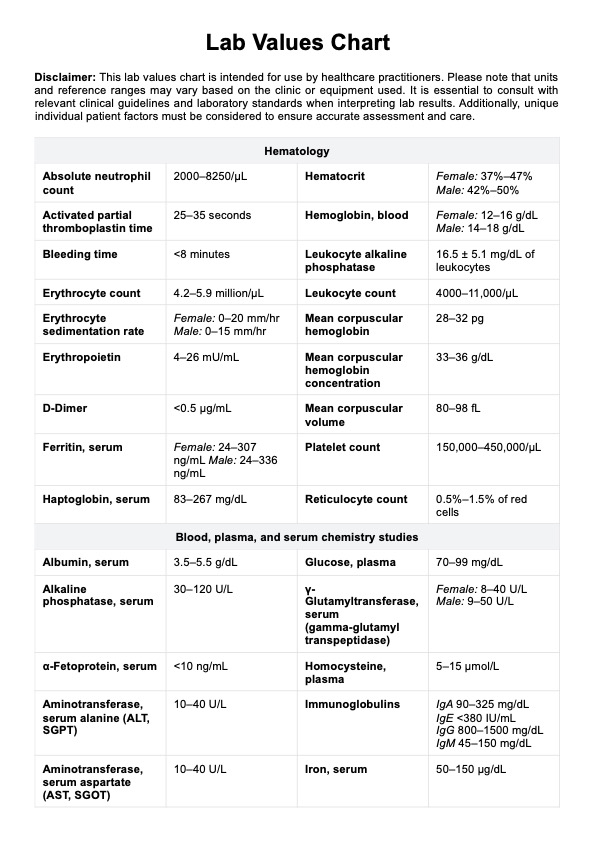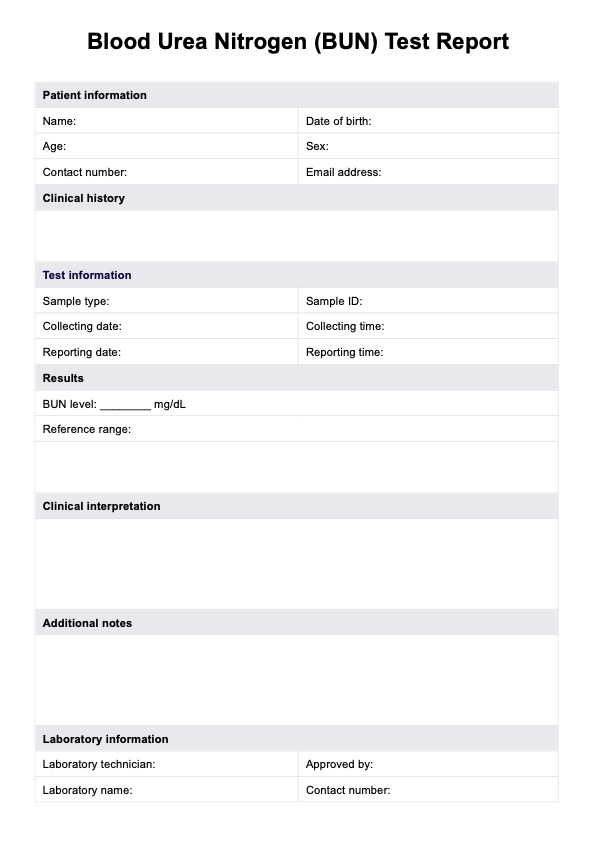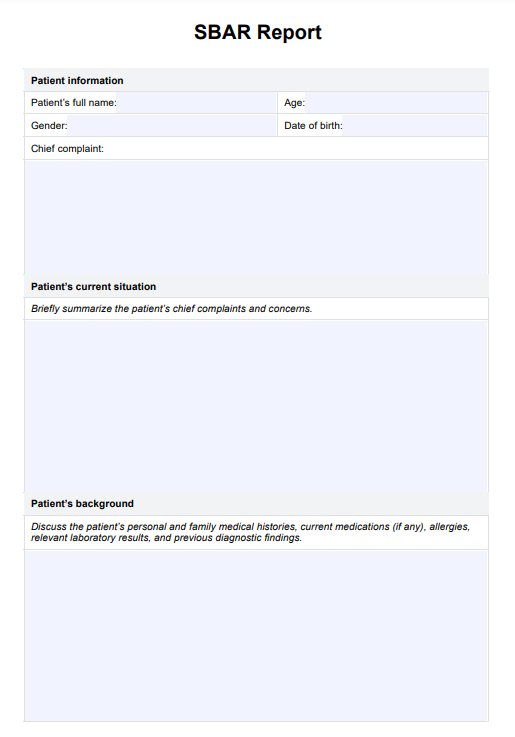Blood Pressure Pregnancy Chart
Pregnancy and blood pressure levels are crucial to the health and well-being of both mother and child. Utilize this informative guide and easy-to-use template to mitigate the risks.


What is a Blood Pressure Pregnancy Chart?
Throughout pregnancy, the body undergoes significant changes to accommodate the growth and development of the fetus. Maintaining a regular blood pressure reading during these nine months is crucial. Blood pressure measures the force of blood against artery walls in two values. The systolic number indicates the arterial pressure during the heartbeats, whereas diastolic indicates the pressure between heartbeats. Elevated pressure can lead to high blood pressure readings, known as hypertension, while decreased pressure may result in low blood pressure readings, known as hypotension.
The presence of hypertension during pregnancy is a cause for concern and requires close monitoring, as the potential risks can cause significant damage. Chronic hypertension, chronic hypertension with superimposed preeclampsia, gestational hypertension, and preeclampsia are all high blood pressure issues associated with pregnancy.
The utilization of a blood pressure pregnancy chart is common and essential in the delivery of safe and effective care for pregnant patients. By collating regular blood pressure results, a clear picture can be formed by analyzing the results against the recommended parameters. Abnormal blood pressure is known as a silent killer for its damaging risks yet undetectable symptoms. Therefore, regular charting of blood pressure measurements and applying any necessary medical interventions is paramount.
Blood pressure is typically categorized into five sections to help define parameters and severity, these remain the same for pregnant patients but may present different risks and symptoms compared to non-pregnant patients:
- Normal: Less than 120/80 mm Hg
- Elevated: Systolic between 120 and 129 mm Hg and diastolic less than 80 mm Hg
- Stage 1 hypertension: Systolic between 130 and 139 mm Hg or diastolic between 80 and 89 mm Hg
- Stage 2 hypertension: Systolic at least 140 mm Hg or diastolic at least 90 mm Hg
- Hypertensive Crisis: Exceeds 180 mm Hg systolic and 120 mm Hg diastolic.
Blood Pressure Pregnancy Chart Template
Blood Pressure Pregnancy Chart Example
How does it work?
Step One: Gather your Resources
Blood pressure charts are a valuable resource and essential to keep on hand. Make sure that you have one when the need arises by either clicking the “Download Template” or “Use Template” button or by searching “ Blood Pressure Pregnancy Chart” on Carepatron’s template library’s search bar on the website or app.
Step Two: Collate Essential Information
Fill out all essential patient information, including any relevant medical history that may impact the parameters. Gestation stage and previous blood pressure issues should be indicated. This form includes an easy-to-use common symptom section for hypertension and hypotension as well as the recommended parameters to make clear interpretations. From this, the need for medical intervention may arise.
Step Three: Store the Template Securely
After reviewing the results, you need to secure the blood pressure chart so that access is only granted to relevant parties. As blood pressure is a commonly recorded result, easy access to the blood pressure chart both by medical practitioner and patient is essential.
Ensure this through Carepatrons HIPAA-compliant free patient records software. Here all relevant medical records can be safely stored and collated for ease and security.
When would you use this chart?
Blood pressure tests are routinely used throughout pregnancy as a standard part of prenatal care. Monitoring blood pressure is crucial during pregnancy to detect and manage potential complications. Here are some common scenarios when blood pressure pregnancy charts are typically conducted:
Routine prenatal visits
Blood pressure is often measured at every prenatal appointment to ensure it remains within the normal range. This regular monitoring helps identify any significant changes early on and offers the opportunity to provide good preventive care.
First prenatal visit
Blood pressure is usually taken during the initial prenatal visit to establish a baseline measurement and solidify a normal level for the individual. This baseline helps healthcare providers identify abnormal levels in future consults and assists with the management of potential risks.
High-risk pregnancies
Women with pre-existing conditions such as chronic hypertension or gestational diabetes may require more frequent blood pressure monitoring to manage potential complications. This may be carried out at home with the levels being charted via a sharable and secure blood pressure pregnancy chart.
Previous pregnancy complications
If a woman has experienced complications related to high blood pressure in a previous pregnancy, monitoring may be more intensive in subsequent pregnancies with at-home, regular charting encouraged.
Signs of preeclampsia
Preeclampsia is a condition characterized by high blood pressure and other organ-related complications. Monitoring blood pressure is crucial for early detection and management of preeclampsia.
Symptoms of high or low blood pressure
If a pregnant patient experiences symptoms such as severe headaches, visual disturbances, abdominal pain, or swelling in the hands and face, healthcare providers may check blood pressure to assess if it's a result of abnormal blood pressure levels. The presence of hypertension and hypotension can put both patient and child at risk of a preterm pregnancy, placental abruption, and preeclampsia.
Medication management
Should a pregnant patient be prescribed blood pressure medication, regular testing is required to monitor pressure levels to ensure that the intervention is effective.
In the third trimester
Blood pressure may be monitored more frequently in the third trimester as the risk of developing gestational hypertension or preeclampsia increases. Regular blood pressure tests help healthcare providers identify and manage any issues promptly, ensuring the well-being of both the mother and the baby.
What do the results mean?
Monitoring blood pressure is a crucial aspect of prenatal care. Blood pressure ranges vary between institutions yet are commonly divided into five key sections as outlined below:
- Normal Range: Blood pressure numbers below 120/80 mm Hg are considered normal. If the results fall within this range, maintain heart-healthy habits, including a balanced diet and regular exercise.
- Elevated: Elevated blood pressure is indicated through measures consistently ranging from 120-129 systolic and less than 80 mm Hg diastolic. Without intervention, individuals with elevated blood pressure are at risk of developing hypertension.
- Hypertension Stage 1: Hypertension Stage 1 is characterized by blood pressure consistently ranging from 130 to 139 systolic or 80 to 89 mm Hg diastolic. At this stage, healthcare professionals are likely to recommend lifestyle changes and may consider prescribing blood pressure medication based on the pregnant patient's risk of developing hypertension. The risk of less blood flow to the placenta, interrupted fetal growth, and premature delivery are all factors to consider.
- Hypertension Stage 2: Hypertension Stage 2 occurs when blood pressure consistently reads 140/90 mm Hg or higher. Healthcare professionals are encouraged to prescribe a combination of blood pressure medications and lifestyle changes at this stage. Hypertension may be present if the patient shows symptoms of flushed skin, swelling of hands and feet, headaches, shortness of breath, nausea, vomiting, and changes in vision. This amount is typically considered the threshold for medical intervention.
- Hypertension Crisis: A hypertensive crisis demands immediate medical attention. If blood pressure readings exceed 180/120 mm Hg, wait five minutes, then retest. If the readings remain high, contact your healthcare professional promptly.
In cases where blood pressure is higher than 180/120 mm Hg and signs of organ damage are present, such as chest pain, back pain, shortness of breath, any numbness or weakness, vision changes, or difficulty speaking, medical assistance is required immediately.
Research & evidence
As per the World Health Organization (2011), preeclampsia continues to stand out as a primary cause of preventable maternal mortality. It impacts approximately 10 million women globally, with preeclampsia and related disorders claiming 76,000 women's lives each year (Kuklina et al., 2009). This manageable condition is one of the leading causes of hospital admission for the pregnant patient population, clearly highlighting the need for early and sustained blood pressure testing for these particular patients (Rosenberg & Twaddle, 1990).
Chronic hypertension is present in patients who had high blood pressure readings prior to becoming pregnant or can be characterized by high blood pressure readings within the first 20 weeks of pregnancy (ACOG, 2022). It is important to note that even if the patient was taking blood pressure medication and had a normal reading prior to pregnancy, they will still be diagnosed with chronic hypertension as a preventative measure. The severity of high blood pressure in pregnant patients cannot go unmissed. Should the patient experience high blood pressure during pregnancy, extra stress may be placed on the heart and kidneys, which can lead to an increased risk of heart disease and stroke (ACOG, 2022). The risk of placental abruption and preterm birth also increases with the presence of high blood pressure, making the regular charting of blood pressure readings in pregnancy invaluable and essential.
There is research done on the effectiveness of regular low-dose aspirin use as a means of managing high blood pressure in pregnant patients to prevent or delay the development of preeclampsia. According to the American College of Obstetricians and Gynecologists (ACOG) low-dose aspirin prophylaxis is highly recommended for patients who possess a high risk of preeclampsia, and this intervention should be initiated between 12 to 28 weeks of gestation and followed through daily until delivery (ACOG, 2018). The early indication of increasing blood pressure through a clear blood pressure chart helps medical professionals make decisions around treatment plans and ultimately can reduce the risk of life-threatening conditions. A simple yet regular test holds the power to determine a great deal of the patient and child's safety, making this an essential resource.
References
ACOG. (2018, July). Low-Dose Aspirin Use During Pregnancy. Www.acog.org. https://www.acog.org/clinical/clinical-guidance/committee-opinion/articles/2018/07/low-dose-aspirin-use-during-pregnancy
ACOG. (2022, April). Preeclampsia and High Blood Pressure During Pregnancy. Www.acog.org. https://www.acog.org/womens-health/faqs/preeclampsia-and-high-blood-pressure-during-pregnancy
Healthline. (2018, February 28). Abnormal Blood Pressure Levels in Pregnancy. Healthline. https://www.healthline.com/health/pregnancy/chronic-hypertension-blood-pressure#causes
Kuklina, E. V., Ayala, C., & Callaghan, W. M. (2009). Hypertensive Disorders and Severe Obstetric Morbidity in the United States. Obstetrics & Gynecology, 113(6), 1299–1306. https://doi.org/10.1097/aog.0b013e3181a45b25
Rosenberg, K., & Twaddle, S. (1990). 6 Screening and surveillance of pregnancy hypertension—an economic approach to the use of daycare. Baillieres Clin Obstet Gynaecol. https://doi.org/10.1016/s0950-3552(05)80214-7
WHO. (2011). WHO recommendations for Prevention and treatment of pre-eclampsia and eclampsia. https://iris.who.int/bitstream/handle/10665/44703/?sequence=1
Commonly asked questions
Healthcare professionals, such as physicians and midwives, often request blood pressure charts to help manage and monitor the risks associated with high blood pressure in pregnant patients.
Blood pressure pregnancy charts are used in various contexts to monitor and assess blood pressure levels during gestation. Both practitioner and patient can utilize blood pressure charts should regular levels need to be taken.
Blood pressure charts are used as visual tools to track and interpret blood pressure readings over time gathered through a sphygmomanometer or automated blood pressure monitor. In pregnancy, they help determine the risks of serious conditions like preeclampsia occurring.


